Business Law Report: English Common Law in Singapore and Legal Aspects
VerifiedAdded on 2023/03/31
|14
|3029
|371
Report
AI Summary
This report provides a comprehensive overview of Singapore's business law, tracing the influence of English common law, particularly through the 1826 Charter of Justice and the subsequent Final Application of English Law Act in 1993. It examines the legal system, emphasizing the doctrine of judicial precedent (stare decisis) and the role of the Singapore Law Reports. The report then details the litigation process, from jurisdiction and commencement of civil suits to pleading, offers to settle, and the roles of various courts. It also covers essential elements of contract law, including offer and acceptance, consideration, intention, and capacity, along with ways an offer can be terminated. Finally, it addresses defenses against negligence suits, such as contributory negligence, voluntary assumption of risk, and inevitable accidents, providing a thorough analysis of key legal concepts in a Singaporean context.
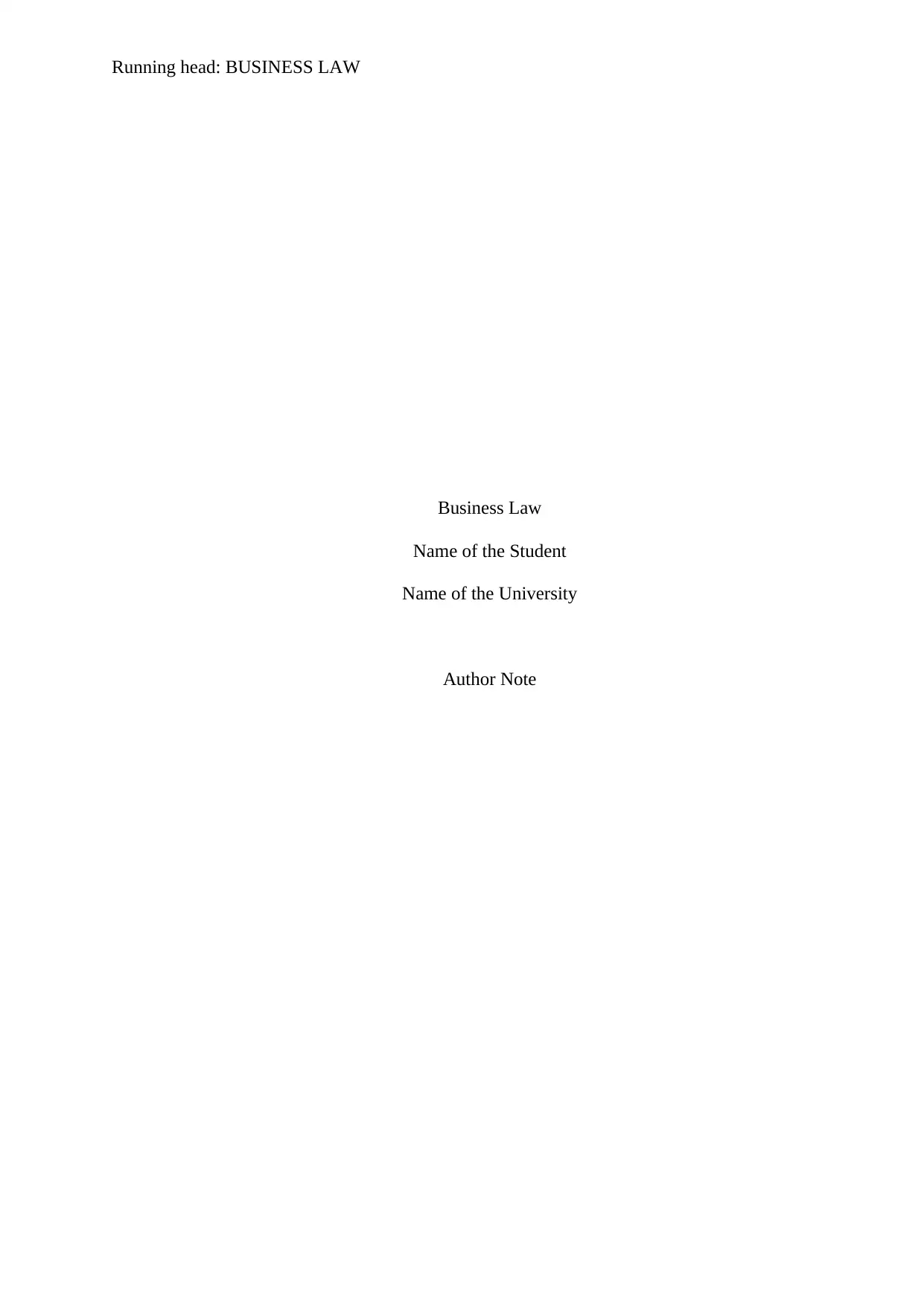
Running head: BUSINESS LAW
Business Law
Name of the Student
Name of the University
Author Note
Business Law
Name of the Student
Name of the University
Author Note
Paraphrase This Document
Need a fresh take? Get an instant paraphrase of this document with our AI Paraphraser
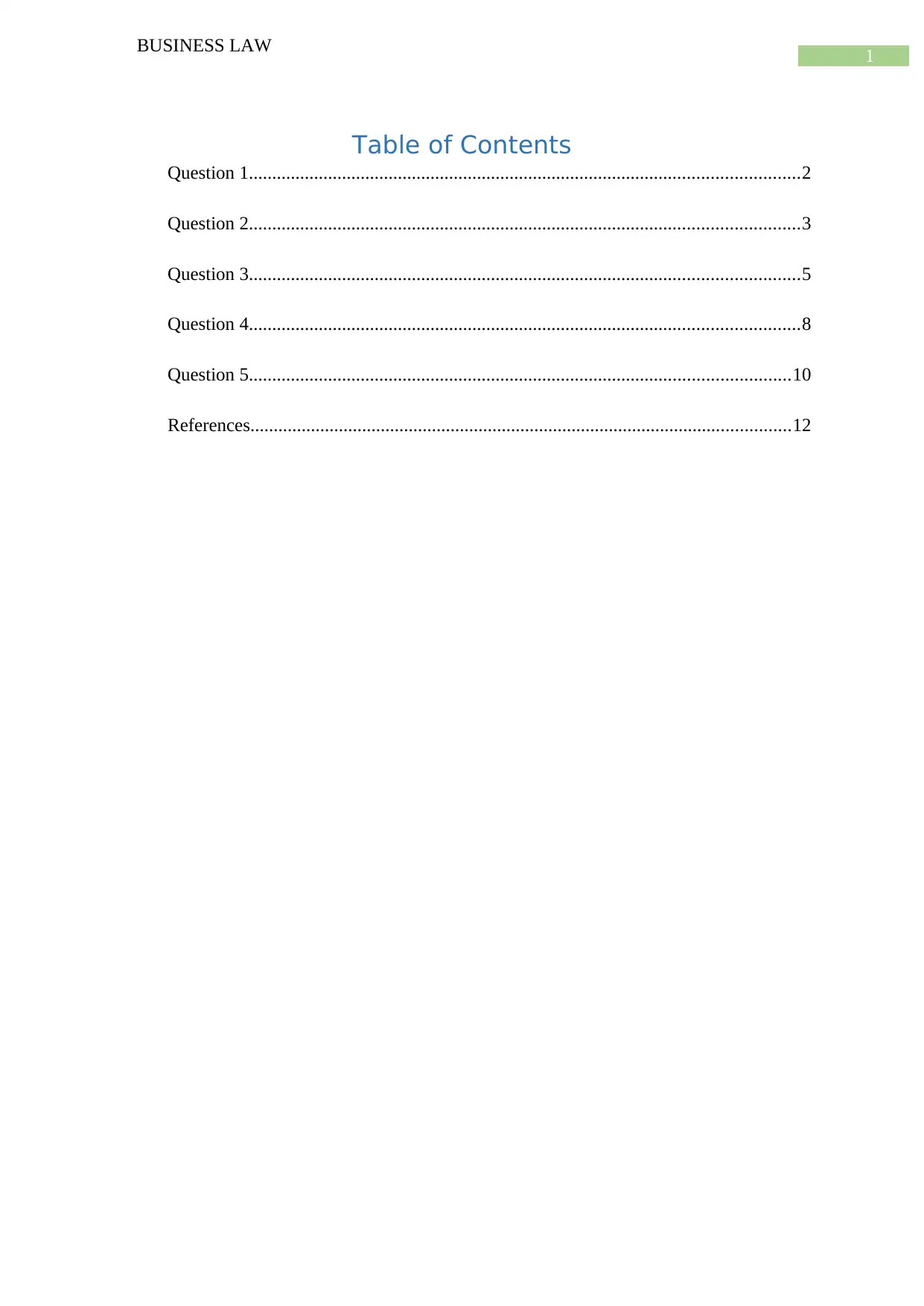
1
BUSINESS LAW
Table of Contents
Question 1......................................................................................................................2
Question 2......................................................................................................................3
Question 3......................................................................................................................5
Question 4......................................................................................................................8
Question 5....................................................................................................................10
References....................................................................................................................12
BUSINESS LAW
Table of Contents
Question 1......................................................................................................................2
Question 2......................................................................................................................3
Question 3......................................................................................................................5
Question 4......................................................................................................................8
Question 5....................................................................................................................10
References....................................................................................................................12
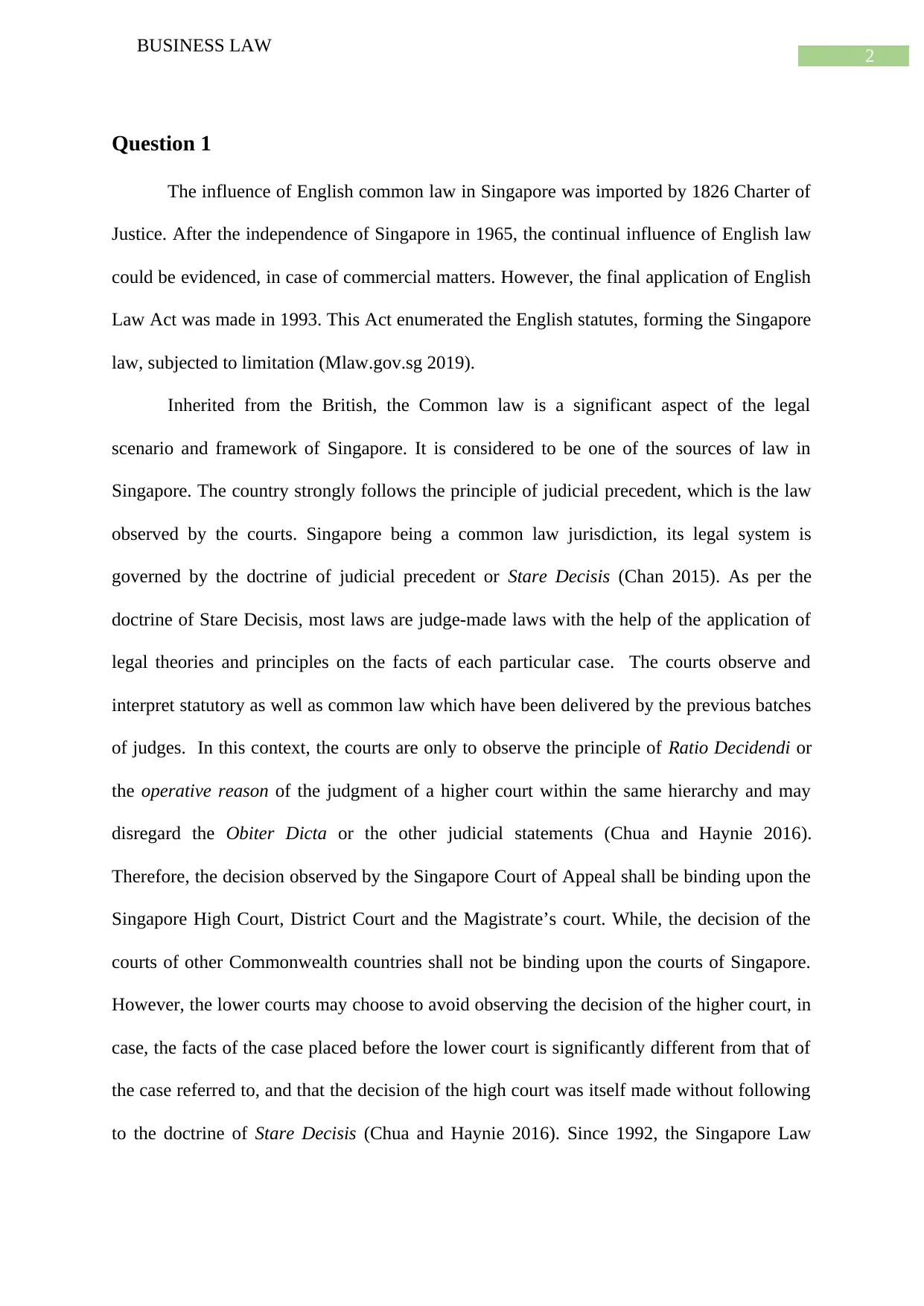
2
BUSINESS LAW
Question 1
The influence of English common law in Singapore was imported by 1826 Charter of
Justice. After the independence of Singapore in 1965, the continual influence of English law
could be evidenced, in case of commercial matters. However, the final application of English
Law Act was made in 1993. This Act enumerated the English statutes, forming the Singapore
law, subjected to limitation (Mlaw.gov.sg 2019).
Inherited from the British, the Common law is a significant aspect of the legal
scenario and framework of Singapore. It is considered to be one of the sources of law in
Singapore. The country strongly follows the principle of judicial precedent, which is the law
observed by the courts. Singapore being a common law jurisdiction, its legal system is
governed by the doctrine of judicial precedent or Stare Decisis (Chan 2015). As per the
doctrine of Stare Decisis, most laws are judge-made laws with the help of the application of
legal theories and principles on the facts of each particular case. The courts observe and
interpret statutory as well as common law which have been delivered by the previous batches
of judges. In this context, the courts are only to observe the principle of Ratio Decidendi or
the operative reason of the judgment of a higher court within the same hierarchy and may
disregard the Obiter Dicta or the other judicial statements (Chua and Haynie 2016).
Therefore, the decision observed by the Singapore Court of Appeal shall be binding upon the
Singapore High Court, District Court and the Magistrate’s court. While, the decision of the
courts of other Commonwealth countries shall not be binding upon the courts of Singapore.
However, the lower courts may choose to avoid observing the decision of the higher court, in
case, the facts of the case placed before the lower court is significantly different from that of
the case referred to, and that the decision of the high court was itself made without following
to the doctrine of Stare Decisis (Chua and Haynie 2016). Since 1992, the Singapore Law
BUSINESS LAW
Question 1
The influence of English common law in Singapore was imported by 1826 Charter of
Justice. After the independence of Singapore in 1965, the continual influence of English law
could be evidenced, in case of commercial matters. However, the final application of English
Law Act was made in 1993. This Act enumerated the English statutes, forming the Singapore
law, subjected to limitation (Mlaw.gov.sg 2019).
Inherited from the British, the Common law is a significant aspect of the legal
scenario and framework of Singapore. It is considered to be one of the sources of law in
Singapore. The country strongly follows the principle of judicial precedent, which is the law
observed by the courts. Singapore being a common law jurisdiction, its legal system is
governed by the doctrine of judicial precedent or Stare Decisis (Chan 2015). As per the
doctrine of Stare Decisis, most laws are judge-made laws with the help of the application of
legal theories and principles on the facts of each particular case. The courts observe and
interpret statutory as well as common law which have been delivered by the previous batches
of judges. In this context, the courts are only to observe the principle of Ratio Decidendi or
the operative reason of the judgment of a higher court within the same hierarchy and may
disregard the Obiter Dicta or the other judicial statements (Chua and Haynie 2016).
Therefore, the decision observed by the Singapore Court of Appeal shall be binding upon the
Singapore High Court, District Court and the Magistrate’s court. While, the decision of the
courts of other Commonwealth countries shall not be binding upon the courts of Singapore.
However, the lower courts may choose to avoid observing the decision of the higher court, in
case, the facts of the case placed before the lower court is significantly different from that of
the case referred to, and that the decision of the high court was itself made without following
to the doctrine of Stare Decisis (Chua and Haynie 2016). Since 1992, the Singapore Law
⊘ This is a preview!⊘
Do you want full access?
Subscribe today to unlock all pages.

Trusted by 1+ million students worldwide
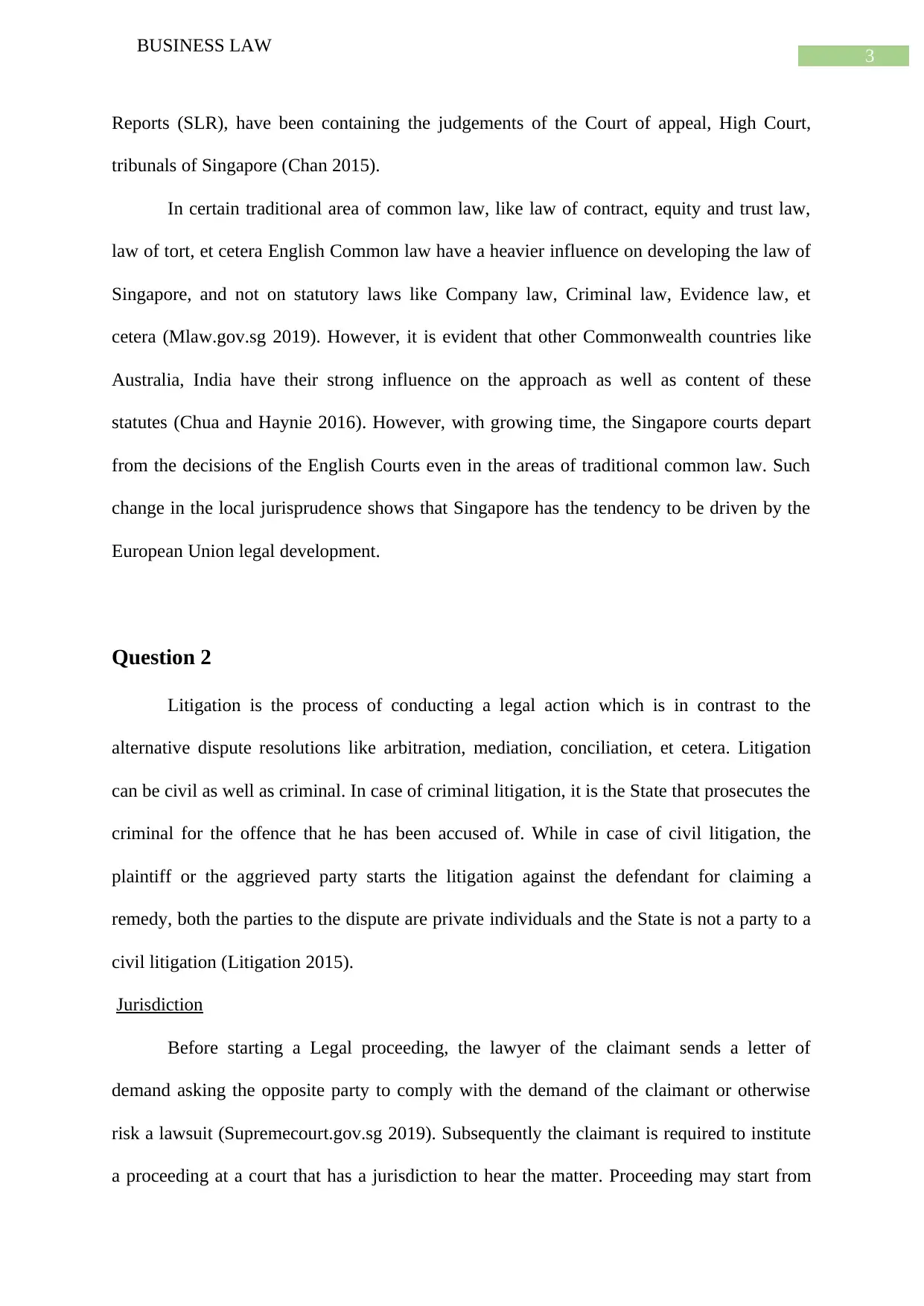
3
BUSINESS LAW
Reports (SLR), have been containing the judgements of the Court of appeal, High Court,
tribunals of Singapore (Chan 2015).
In certain traditional area of common law, like law of contract, equity and trust law,
law of tort, et cetera English Common law have a heavier influence on developing the law of
Singapore, and not on statutory laws like Company law, Criminal law, Evidence law, et
cetera (Mlaw.gov.sg 2019). However, it is evident that other Commonwealth countries like
Australia, India have their strong influence on the approach as well as content of these
statutes (Chua and Haynie 2016). However, with growing time, the Singapore courts depart
from the decisions of the English Courts even in the areas of traditional common law. Such
change in the local jurisprudence shows that Singapore has the tendency to be driven by the
European Union legal development.
Question 2
Litigation is the process of conducting a legal action which is in contrast to the
alternative dispute resolutions like arbitration, mediation, conciliation, et cetera. Litigation
can be civil as well as criminal. In case of criminal litigation, it is the State that prosecutes the
criminal for the offence that he has been accused of. While in case of civil litigation, the
plaintiff or the aggrieved party starts the litigation against the defendant for claiming a
remedy, both the parties to the dispute are private individuals and the State is not a party to a
civil litigation (Litigation 2015).
Jurisdiction
Before starting a Legal proceeding, the lawyer of the claimant sends a letter of
demand asking the opposite party to comply with the demand of the claimant or otherwise
risk a lawsuit (Supremecourt.gov.sg 2019). Subsequently the claimant is required to institute
a proceeding at a court that has a jurisdiction to hear the matter. Proceeding may start from
BUSINESS LAW
Reports (SLR), have been containing the judgements of the Court of appeal, High Court,
tribunals of Singapore (Chan 2015).
In certain traditional area of common law, like law of contract, equity and trust law,
law of tort, et cetera English Common law have a heavier influence on developing the law of
Singapore, and not on statutory laws like Company law, Criminal law, Evidence law, et
cetera (Mlaw.gov.sg 2019). However, it is evident that other Commonwealth countries like
Australia, India have their strong influence on the approach as well as content of these
statutes (Chua and Haynie 2016). However, with growing time, the Singapore courts depart
from the decisions of the English Courts even in the areas of traditional common law. Such
change in the local jurisprudence shows that Singapore has the tendency to be driven by the
European Union legal development.
Question 2
Litigation is the process of conducting a legal action which is in contrast to the
alternative dispute resolutions like arbitration, mediation, conciliation, et cetera. Litigation
can be civil as well as criminal. In case of criminal litigation, it is the State that prosecutes the
criminal for the offence that he has been accused of. While in case of civil litigation, the
plaintiff or the aggrieved party starts the litigation against the defendant for claiming a
remedy, both the parties to the dispute are private individuals and the State is not a party to a
civil litigation (Litigation 2015).
Jurisdiction
Before starting a Legal proceeding, the lawyer of the claimant sends a letter of
demand asking the opposite party to comply with the demand of the claimant or otherwise
risk a lawsuit (Supremecourt.gov.sg 2019). Subsequently the claimant is required to institute
a proceeding at a court that has a jurisdiction to hear the matter. Proceeding may start from
Paraphrase This Document
Need a fresh take? Get an instant paraphrase of this document with our AI Paraphraser
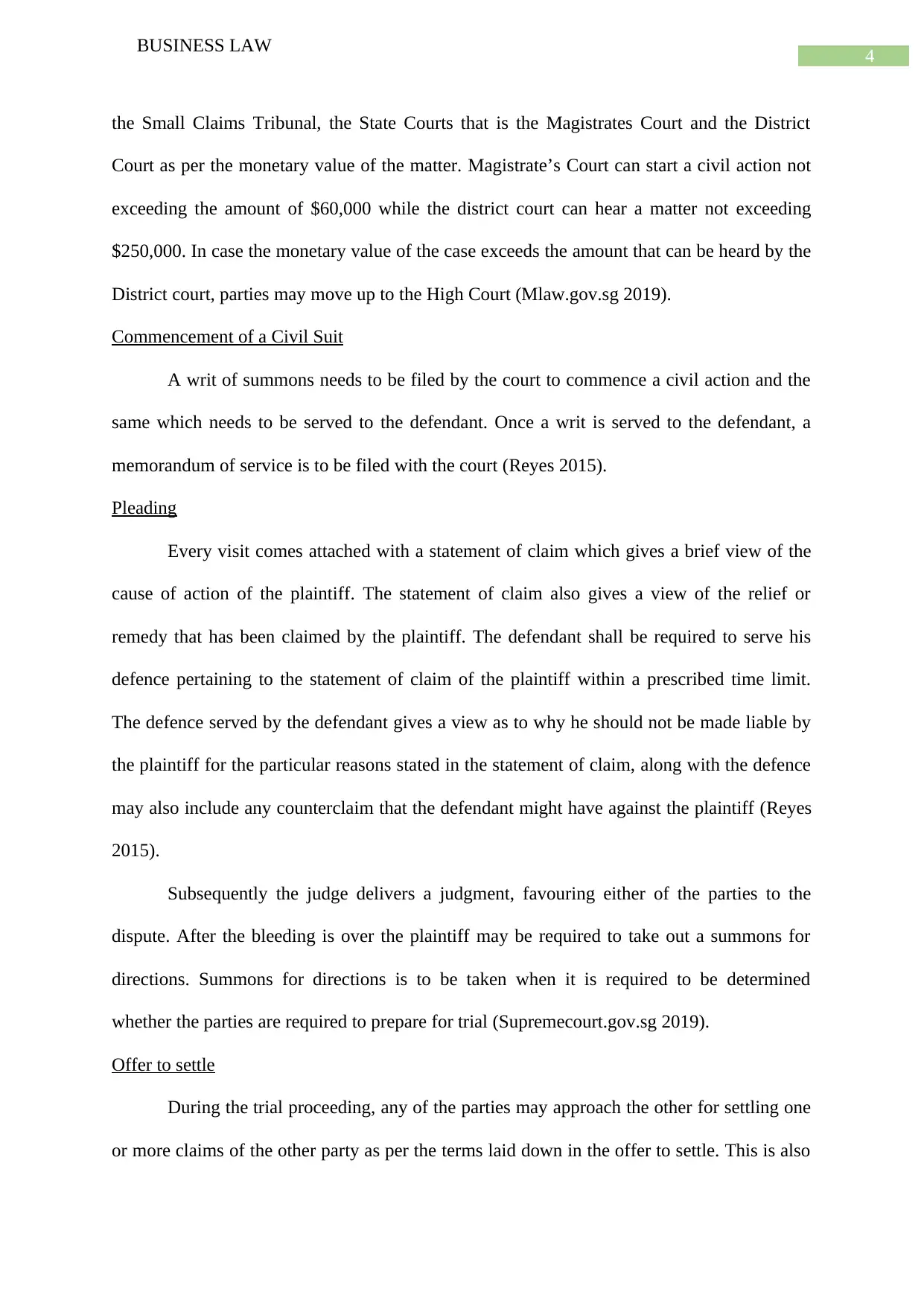
4
BUSINESS LAW
the Small Claims Tribunal, the State Courts that is the Magistrates Court and the District
Court as per the monetary value of the matter. Magistrate’s Court can start a civil action not
exceeding the amount of $60,000 while the district court can hear a matter not exceeding
$250,000. In case the monetary value of the case exceeds the amount that can be heard by the
District court, parties may move up to the High Court (Mlaw.gov.sg 2019).
Commencement of a Civil Suit
A writ of summons needs to be filed by the court to commence a civil action and the
same which needs to be served to the defendant. Once a writ is served to the defendant, a
memorandum of service is to be filed with the court (Reyes 2015).
Pleading
Every visit comes attached with a statement of claim which gives a brief view of the
cause of action of the plaintiff. The statement of claim also gives a view of the relief or
remedy that has been claimed by the plaintiff. The defendant shall be required to serve his
defence pertaining to the statement of claim of the plaintiff within a prescribed time limit.
The defence served by the defendant gives a view as to why he should not be made liable by
the plaintiff for the particular reasons stated in the statement of claim, along with the defence
may also include any counterclaim that the defendant might have against the plaintiff (Reyes
2015).
Subsequently the judge delivers a judgment, favouring either of the parties to the
dispute. After the bleeding is over the plaintiff may be required to take out a summons for
directions. Summons for directions is to be taken when it is required to be determined
whether the parties are required to prepare for trial (Supremecourt.gov.sg 2019).
Offer to settle
During the trial proceeding, any of the parties may approach the other for settling one
or more claims of the other party as per the terms laid down in the offer to settle. This is also
BUSINESS LAW
the Small Claims Tribunal, the State Courts that is the Magistrates Court and the District
Court as per the monetary value of the matter. Magistrate’s Court can start a civil action not
exceeding the amount of $60,000 while the district court can hear a matter not exceeding
$250,000. In case the monetary value of the case exceeds the amount that can be heard by the
District court, parties may move up to the High Court (Mlaw.gov.sg 2019).
Commencement of a Civil Suit
A writ of summons needs to be filed by the court to commence a civil action and the
same which needs to be served to the defendant. Once a writ is served to the defendant, a
memorandum of service is to be filed with the court (Reyes 2015).
Pleading
Every visit comes attached with a statement of claim which gives a brief view of the
cause of action of the plaintiff. The statement of claim also gives a view of the relief or
remedy that has been claimed by the plaintiff. The defendant shall be required to serve his
defence pertaining to the statement of claim of the plaintiff within a prescribed time limit.
The defence served by the defendant gives a view as to why he should not be made liable by
the plaintiff for the particular reasons stated in the statement of claim, along with the defence
may also include any counterclaim that the defendant might have against the plaintiff (Reyes
2015).
Subsequently the judge delivers a judgment, favouring either of the parties to the
dispute. After the bleeding is over the plaintiff may be required to take out a summons for
directions. Summons for directions is to be taken when it is required to be determined
whether the parties are required to prepare for trial (Supremecourt.gov.sg 2019).
Offer to settle
During the trial proceeding, any of the parties may approach the other for settling one
or more claims of the other party as per the terms laid down in the offer to settle. This is also
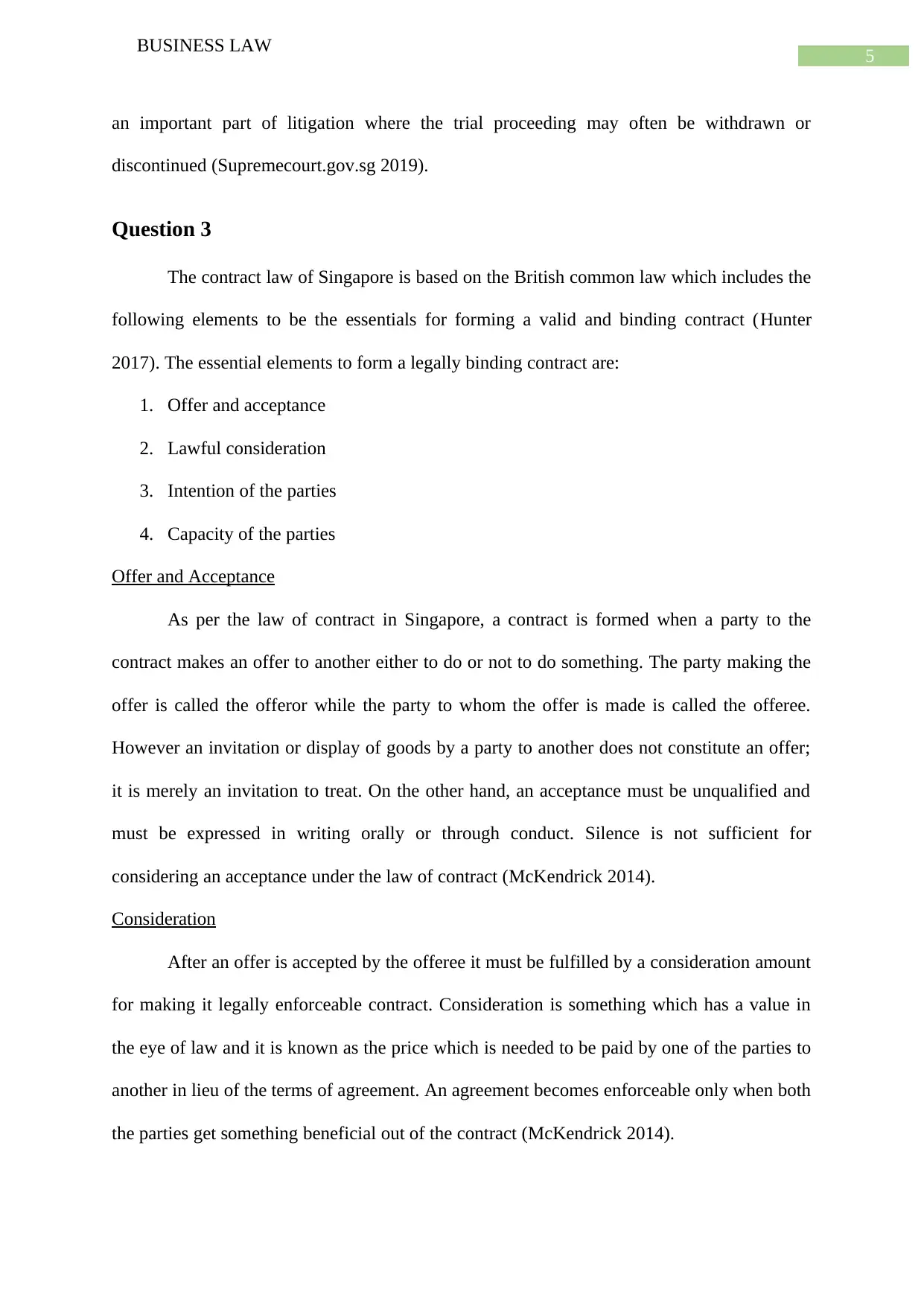
5
BUSINESS LAW
an important part of litigation where the trial proceeding may often be withdrawn or
discontinued (Supremecourt.gov.sg 2019).
Question 3
The contract law of Singapore is based on the British common law which includes the
following elements to be the essentials for forming a valid and binding contract (Hunter
2017). The essential elements to form a legally binding contract are:
1. Offer and acceptance
2. Lawful consideration
3. Intention of the parties
4. Capacity of the parties
Offer and Acceptance
As per the law of contract in Singapore, a contract is formed when a party to the
contract makes an offer to another either to do or not to do something. The party making the
offer is called the offeror while the party to whom the offer is made is called the offeree.
However an invitation or display of goods by a party to another does not constitute an offer;
it is merely an invitation to treat. On the other hand, an acceptance must be unqualified and
must be expressed in writing orally or through conduct. Silence is not sufficient for
considering an acceptance under the law of contract (McKendrick 2014).
Consideration
After an offer is accepted by the offeree it must be fulfilled by a consideration amount
for making it legally enforceable contract. Consideration is something which has a value in
the eye of law and it is known as the price which is needed to be paid by one of the parties to
another in lieu of the terms of agreement. An agreement becomes enforceable only when both
the parties get something beneficial out of the contract (McKendrick 2014).
BUSINESS LAW
an important part of litigation where the trial proceeding may often be withdrawn or
discontinued (Supremecourt.gov.sg 2019).
Question 3
The contract law of Singapore is based on the British common law which includes the
following elements to be the essentials for forming a valid and binding contract (Hunter
2017). The essential elements to form a legally binding contract are:
1. Offer and acceptance
2. Lawful consideration
3. Intention of the parties
4. Capacity of the parties
Offer and Acceptance
As per the law of contract in Singapore, a contract is formed when a party to the
contract makes an offer to another either to do or not to do something. The party making the
offer is called the offeror while the party to whom the offer is made is called the offeree.
However an invitation or display of goods by a party to another does not constitute an offer;
it is merely an invitation to treat. On the other hand, an acceptance must be unqualified and
must be expressed in writing orally or through conduct. Silence is not sufficient for
considering an acceptance under the law of contract (McKendrick 2014).
Consideration
After an offer is accepted by the offeree it must be fulfilled by a consideration amount
for making it legally enforceable contract. Consideration is something which has a value in
the eye of law and it is known as the price which is needed to be paid by one of the parties to
another in lieu of the terms of agreement. An agreement becomes enforceable only when both
the parties get something beneficial out of the contract (McKendrick 2014).
⊘ This is a preview!⊘
Do you want full access?
Subscribe today to unlock all pages.

Trusted by 1+ million students worldwide
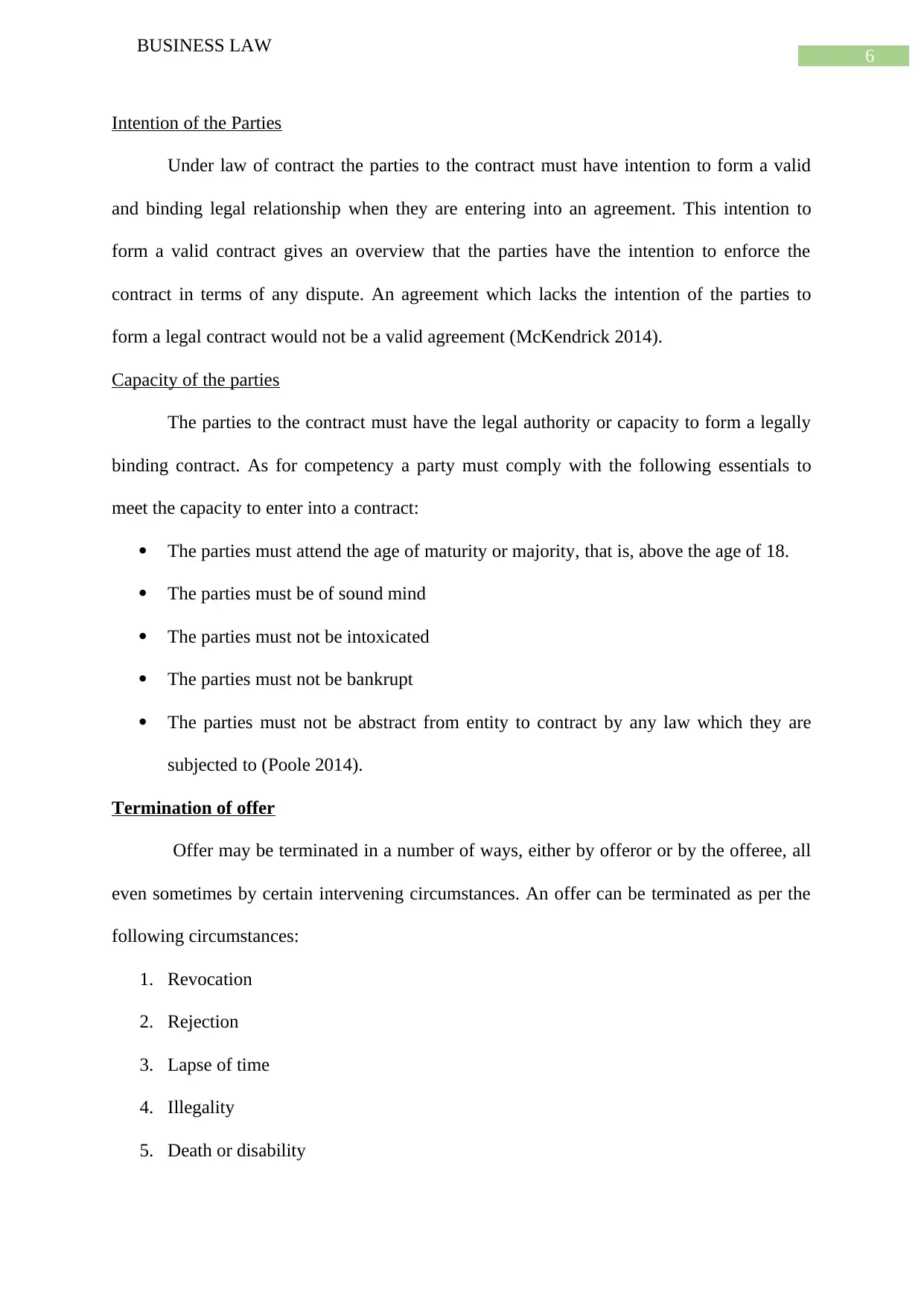
6
BUSINESS LAW
Intention of the Parties
Under law of contract the parties to the contract must have intention to form a valid
and binding legal relationship when they are entering into an agreement. This intention to
form a valid contract gives an overview that the parties have the intention to enforce the
contract in terms of any dispute. An agreement which lacks the intention of the parties to
form a legal contract would not be a valid agreement (McKendrick 2014).
Capacity of the parties
The parties to the contract must have the legal authority or capacity to form a legally
binding contract. As for competency a party must comply with the following essentials to
meet the capacity to enter into a contract:
The parties must attend the age of maturity or majority, that is, above the age of 18.
The parties must be of sound mind
The parties must not be intoxicated
The parties must not be bankrupt
The parties must not be abstract from entity to contract by any law which they are
subjected to (Poole 2014).
Termination of offer
Offer may be terminated in a number of ways, either by offeror or by the offeree, all
even sometimes by certain intervening circumstances. An offer can be terminated as per the
following circumstances:
1. Revocation
2. Rejection
3. Lapse of time
4. Illegality
5. Death or disability
BUSINESS LAW
Intention of the Parties
Under law of contract the parties to the contract must have intention to form a valid
and binding legal relationship when they are entering into an agreement. This intention to
form a valid contract gives an overview that the parties have the intention to enforce the
contract in terms of any dispute. An agreement which lacks the intention of the parties to
form a legal contract would not be a valid agreement (McKendrick 2014).
Capacity of the parties
The parties to the contract must have the legal authority or capacity to form a legally
binding contract. As for competency a party must comply with the following essentials to
meet the capacity to enter into a contract:
The parties must attend the age of maturity or majority, that is, above the age of 18.
The parties must be of sound mind
The parties must not be intoxicated
The parties must not be bankrupt
The parties must not be abstract from entity to contract by any law which they are
subjected to (Poole 2014).
Termination of offer
Offer may be terminated in a number of ways, either by offeror or by the offeree, all
even sometimes by certain intervening circumstances. An offer can be terminated as per the
following circumstances:
1. Revocation
2. Rejection
3. Lapse of time
4. Illegality
5. Death or disability
Paraphrase This Document
Need a fresh take? Get an instant paraphrase of this document with our AI Paraphraser
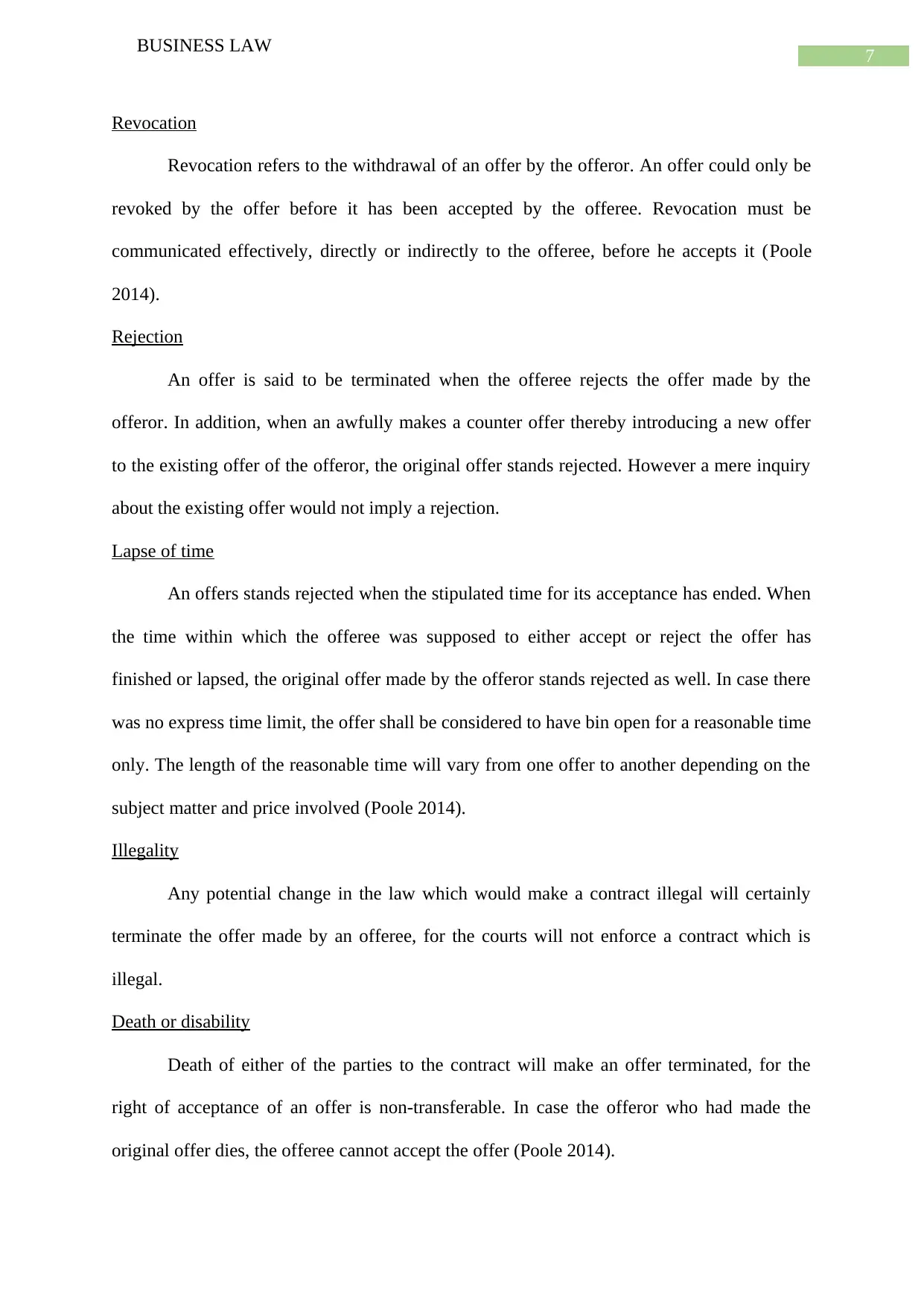
7
BUSINESS LAW
Revocation
Revocation refers to the withdrawal of an offer by the offeror. An offer could only be
revoked by the offer before it has been accepted by the offeree. Revocation must be
communicated effectively, directly or indirectly to the offeree, before he accepts it (Poole
2014).
Rejection
An offer is said to be terminated when the offeree rejects the offer made by the
offeror. In addition, when an awfully makes a counter offer thereby introducing a new offer
to the existing offer of the offeror, the original offer stands rejected. However a mere inquiry
about the existing offer would not imply a rejection.
Lapse of time
An offers stands rejected when the stipulated time for its acceptance has ended. When
the time within which the offeree was supposed to either accept or reject the offer has
finished or lapsed, the original offer made by the offeror stands rejected as well. In case there
was no express time limit, the offer shall be considered to have bin open for a reasonable time
only. The length of the reasonable time will vary from one offer to another depending on the
subject matter and price involved (Poole 2014).
Illegality
Any potential change in the law which would make a contract illegal will certainly
terminate the offer made by an offeree, for the courts will not enforce a contract which is
illegal.
Death or disability
Death of either of the parties to the contract will make an offer terminated, for the
right of acceptance of an offer is non-transferable. In case the offeror who had made the
original offer dies, the offeree cannot accept the offer (Poole 2014).
BUSINESS LAW
Revocation
Revocation refers to the withdrawal of an offer by the offeror. An offer could only be
revoked by the offer before it has been accepted by the offeree. Revocation must be
communicated effectively, directly or indirectly to the offeree, before he accepts it (Poole
2014).
Rejection
An offer is said to be terminated when the offeree rejects the offer made by the
offeror. In addition, when an awfully makes a counter offer thereby introducing a new offer
to the existing offer of the offeror, the original offer stands rejected. However a mere inquiry
about the existing offer would not imply a rejection.
Lapse of time
An offers stands rejected when the stipulated time for its acceptance has ended. When
the time within which the offeree was supposed to either accept or reject the offer has
finished or lapsed, the original offer made by the offeror stands rejected as well. In case there
was no express time limit, the offer shall be considered to have bin open for a reasonable time
only. The length of the reasonable time will vary from one offer to another depending on the
subject matter and price involved (Poole 2014).
Illegality
Any potential change in the law which would make a contract illegal will certainly
terminate the offer made by an offeree, for the courts will not enforce a contract which is
illegal.
Death or disability
Death of either of the parties to the contract will make an offer terminated, for the
right of acceptance of an offer is non-transferable. In case the offeror who had made the
original offer dies, the offeree cannot accept the offer (Poole 2014).
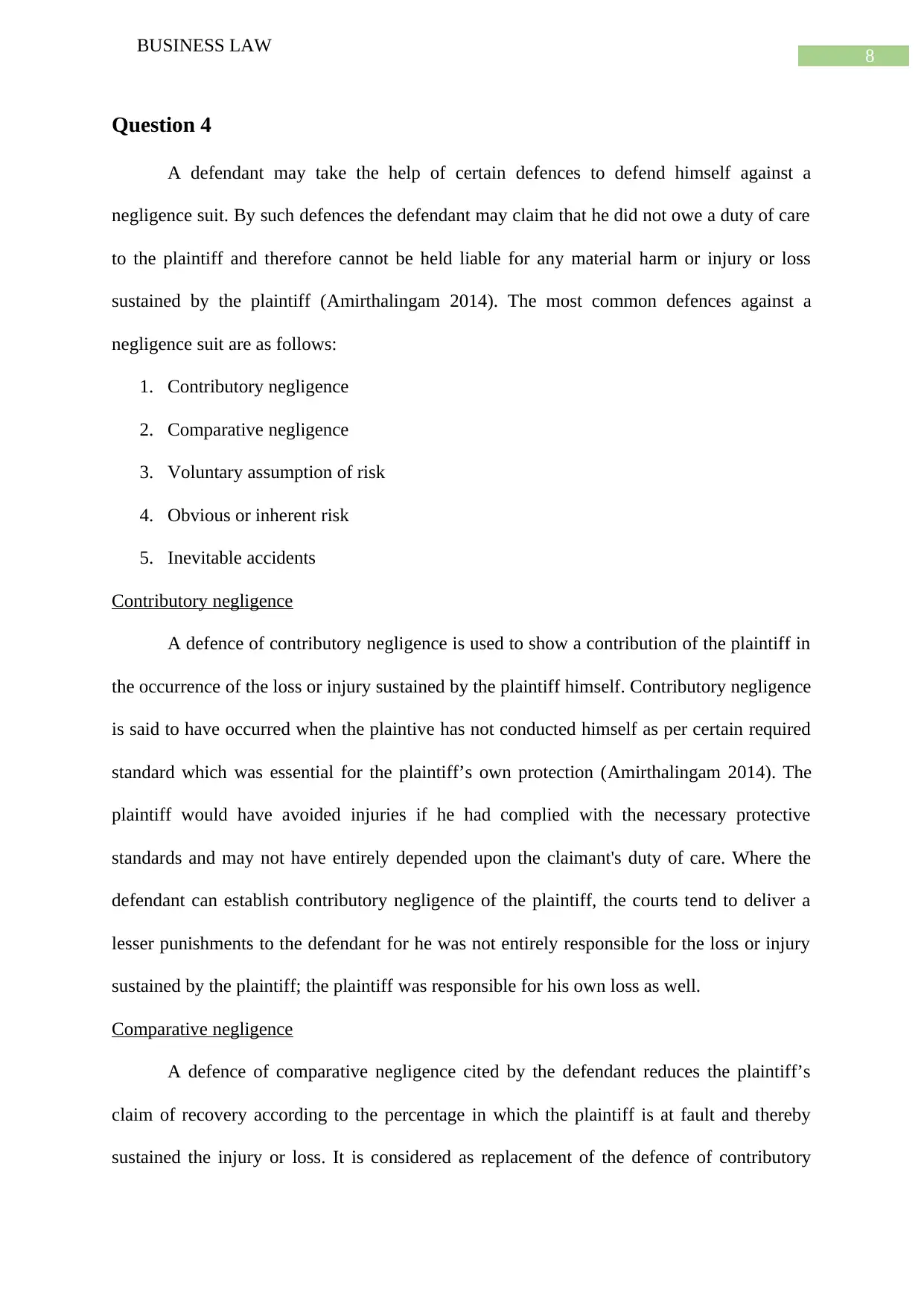
8
BUSINESS LAW
Question 4
A defendant may take the help of certain defences to defend himself against a
negligence suit. By such defences the defendant may claim that he did not owe a duty of care
to the plaintiff and therefore cannot be held liable for any material harm or injury or loss
sustained by the plaintiff (Amirthalingam 2014). The most common defences against a
negligence suit are as follows:
1. Contributory negligence
2. Comparative negligence
3. Voluntary assumption of risk
4. Obvious or inherent risk
5. Inevitable accidents
Contributory negligence
A defence of contributory negligence is used to show a contribution of the plaintiff in
the occurrence of the loss or injury sustained by the plaintiff himself. Contributory negligence
is said to have occurred when the plaintive has not conducted himself as per certain required
standard which was essential for the plaintiff’s own protection (Amirthalingam 2014). The
plaintiff would have avoided injuries if he had complied with the necessary protective
standards and may not have entirely depended upon the claimant's duty of care. Where the
defendant can establish contributory negligence of the plaintiff, the courts tend to deliver a
lesser punishments to the defendant for he was not entirely responsible for the loss or injury
sustained by the plaintiff; the plaintiff was responsible for his own loss as well.
Comparative negligence
A defence of comparative negligence cited by the defendant reduces the plaintiff’s
claim of recovery according to the percentage in which the plaintiff is at fault and thereby
sustained the injury or loss. It is considered as replacement of the defence of contributory
BUSINESS LAW
Question 4
A defendant may take the help of certain defences to defend himself against a
negligence suit. By such defences the defendant may claim that he did not owe a duty of care
to the plaintiff and therefore cannot be held liable for any material harm or injury or loss
sustained by the plaintiff (Amirthalingam 2014). The most common defences against a
negligence suit are as follows:
1. Contributory negligence
2. Comparative negligence
3. Voluntary assumption of risk
4. Obvious or inherent risk
5. Inevitable accidents
Contributory negligence
A defence of contributory negligence is used to show a contribution of the plaintiff in
the occurrence of the loss or injury sustained by the plaintiff himself. Contributory negligence
is said to have occurred when the plaintive has not conducted himself as per certain required
standard which was essential for the plaintiff’s own protection (Amirthalingam 2014). The
plaintiff would have avoided injuries if he had complied with the necessary protective
standards and may not have entirely depended upon the claimant's duty of care. Where the
defendant can establish contributory negligence of the plaintiff, the courts tend to deliver a
lesser punishments to the defendant for he was not entirely responsible for the loss or injury
sustained by the plaintiff; the plaintiff was responsible for his own loss as well.
Comparative negligence
A defence of comparative negligence cited by the defendant reduces the plaintiff’s
claim of recovery according to the percentage in which the plaintiff is at fault and thereby
sustained the injury or loss. It is considered as replacement of the defence of contributory
⊘ This is a preview!⊘
Do you want full access?
Subscribe today to unlock all pages.

Trusted by 1+ million students worldwide
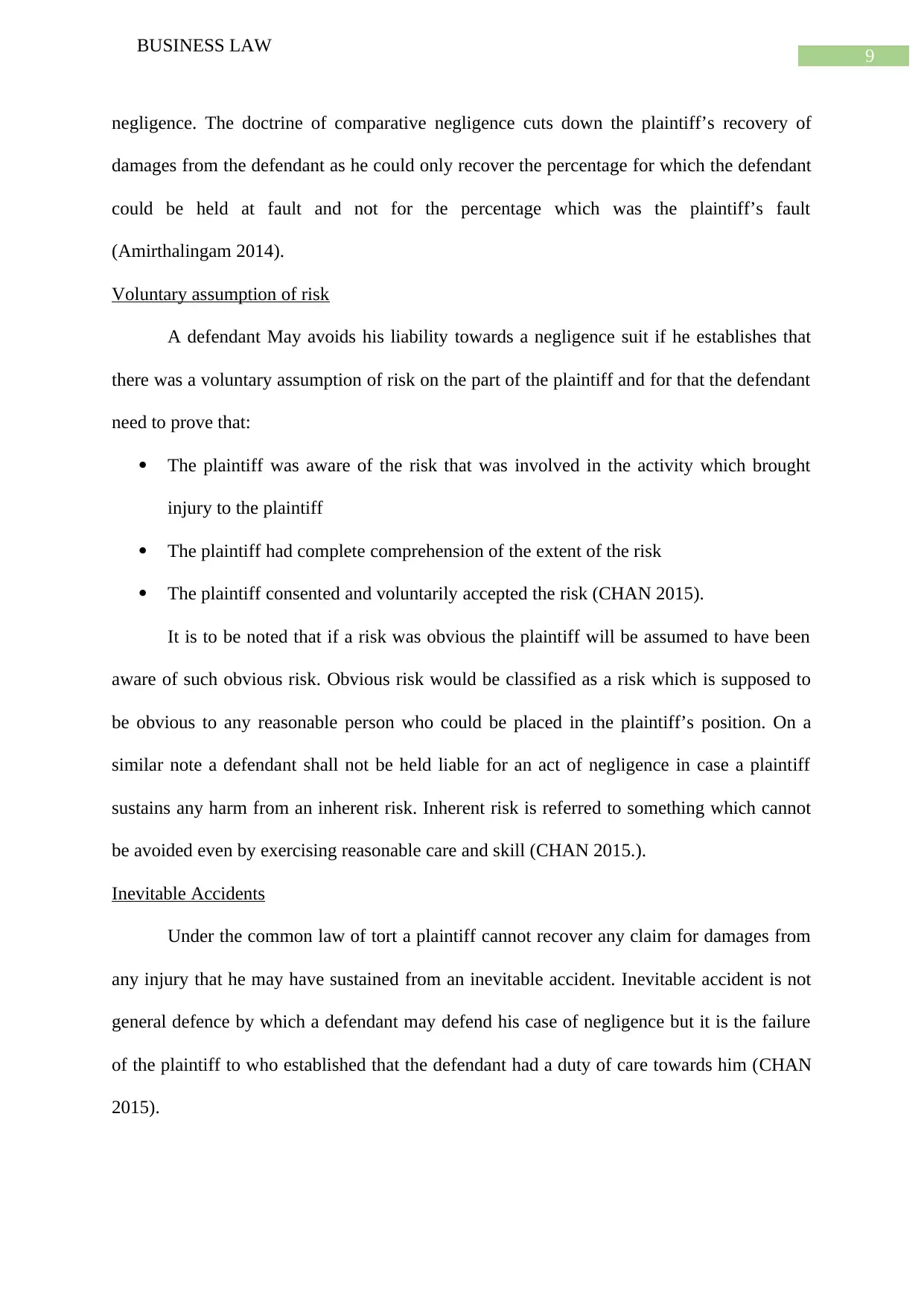
9
BUSINESS LAW
negligence. The doctrine of comparative negligence cuts down the plaintiff’s recovery of
damages from the defendant as he could only recover the percentage for which the defendant
could be held at fault and not for the percentage which was the plaintiff’s fault
(Amirthalingam 2014).
Voluntary assumption of risk
A defendant May avoids his liability towards a negligence suit if he establishes that
there was a voluntary assumption of risk on the part of the plaintiff and for that the defendant
need to prove that:
The plaintiff was aware of the risk that was involved in the activity which brought
injury to the plaintiff
The plaintiff had complete comprehension of the extent of the risk
The plaintiff consented and voluntarily accepted the risk (CHAN 2015).
It is to be noted that if a risk was obvious the plaintiff will be assumed to have been
aware of such obvious risk. Obvious risk would be classified as a risk which is supposed to
be obvious to any reasonable person who could be placed in the plaintiff’s position. On a
similar note a defendant shall not be held liable for an act of negligence in case a plaintiff
sustains any harm from an inherent risk. Inherent risk is referred to something which cannot
be avoided even by exercising reasonable care and skill (CHAN 2015.).
Inevitable Accidents
Under the common law of tort a plaintiff cannot recover any claim for damages from
any injury that he may have sustained from an inevitable accident. Inevitable accident is not
general defence by which a defendant may defend his case of negligence but it is the failure
of the plaintiff to who established that the defendant had a duty of care towards him (CHAN
2015).
BUSINESS LAW
negligence. The doctrine of comparative negligence cuts down the plaintiff’s recovery of
damages from the defendant as he could only recover the percentage for which the defendant
could be held at fault and not for the percentage which was the plaintiff’s fault
(Amirthalingam 2014).
Voluntary assumption of risk
A defendant May avoids his liability towards a negligence suit if he establishes that
there was a voluntary assumption of risk on the part of the plaintiff and for that the defendant
need to prove that:
The plaintiff was aware of the risk that was involved in the activity which brought
injury to the plaintiff
The plaintiff had complete comprehension of the extent of the risk
The plaintiff consented and voluntarily accepted the risk (CHAN 2015).
It is to be noted that if a risk was obvious the plaintiff will be assumed to have been
aware of such obvious risk. Obvious risk would be classified as a risk which is supposed to
be obvious to any reasonable person who could be placed in the plaintiff’s position. On a
similar note a defendant shall not be held liable for an act of negligence in case a plaintiff
sustains any harm from an inherent risk. Inherent risk is referred to something which cannot
be avoided even by exercising reasonable care and skill (CHAN 2015.).
Inevitable Accidents
Under the common law of tort a plaintiff cannot recover any claim for damages from
any injury that he may have sustained from an inevitable accident. Inevitable accident is not
general defence by which a defendant may defend his case of negligence but it is the failure
of the plaintiff to who established that the defendant had a duty of care towards him (CHAN
2015).
Paraphrase This Document
Need a fresh take? Get an instant paraphrase of this document with our AI Paraphraser

10
BUSINESS LAW
Question 5
Duties of a director owed to a company
The Companies Act 2014, the amended Companies Act of Singapore lays down
certain statutory duties of a director which is owed to a company.
Maintaining Accounting Records
Section 114 of the Companies Act 2014 states that the directors shall keep accounting
records of the company which will give an explanation of the financial position of such
company. Search vision statement should be easily accessible by the directors in case and
inspection is necessary. Failure to do so would make the directors guilty of an offence.
Maintaining Annual Accounts
Section 116 of the Companies Act 2014 asks the directors to submit the financial
statement of the company to the shareholders at the Annual General Meeting.
Holding of Meetings
Section 91 of the Companies Act 2014 asks the director to hold an Annual General
meeting once in every calendar year. Section 92 of the Act asks the director to hold
extraordinary General meeting in times of need and requests made by the members. Section
174 of the Act ask the director to hold a General meeting for a statutory meeting within no
less than 1 month or for more than 3 months from the date on which the business was started
(Wawryszuk-Misztal and Wrońska-Bukalska 2014).
Duty to disclose interests in transactions
Section 156 of the Act asks a director to disclose the information in case he is
personally interested in a transaction. Such disclosure is important when the director has a
personal interest or gain from such transaction and therefore must disclose about such
personal gains at a directors' meeting.
BUSINESS LAW
Question 5
Duties of a director owed to a company
The Companies Act 2014, the amended Companies Act of Singapore lays down
certain statutory duties of a director which is owed to a company.
Maintaining Accounting Records
Section 114 of the Companies Act 2014 states that the directors shall keep accounting
records of the company which will give an explanation of the financial position of such
company. Search vision statement should be easily accessible by the directors in case and
inspection is necessary. Failure to do so would make the directors guilty of an offence.
Maintaining Annual Accounts
Section 116 of the Companies Act 2014 asks the directors to submit the financial
statement of the company to the shareholders at the Annual General Meeting.
Holding of Meetings
Section 91 of the Companies Act 2014 asks the director to hold an Annual General
meeting once in every calendar year. Section 92 of the Act asks the director to hold
extraordinary General meeting in times of need and requests made by the members. Section
174 of the Act ask the director to hold a General meeting for a statutory meeting within no
less than 1 month or for more than 3 months from the date on which the business was started
(Wawryszuk-Misztal and Wrońska-Bukalska 2014).
Duty to disclose interests in transactions
Section 156 of the Act asks a director to disclose the information in case he is
personally interested in a transaction. Such disclosure is important when the director has a
personal interest or gain from such transaction and therefore must disclose about such
personal gains at a directors' meeting.
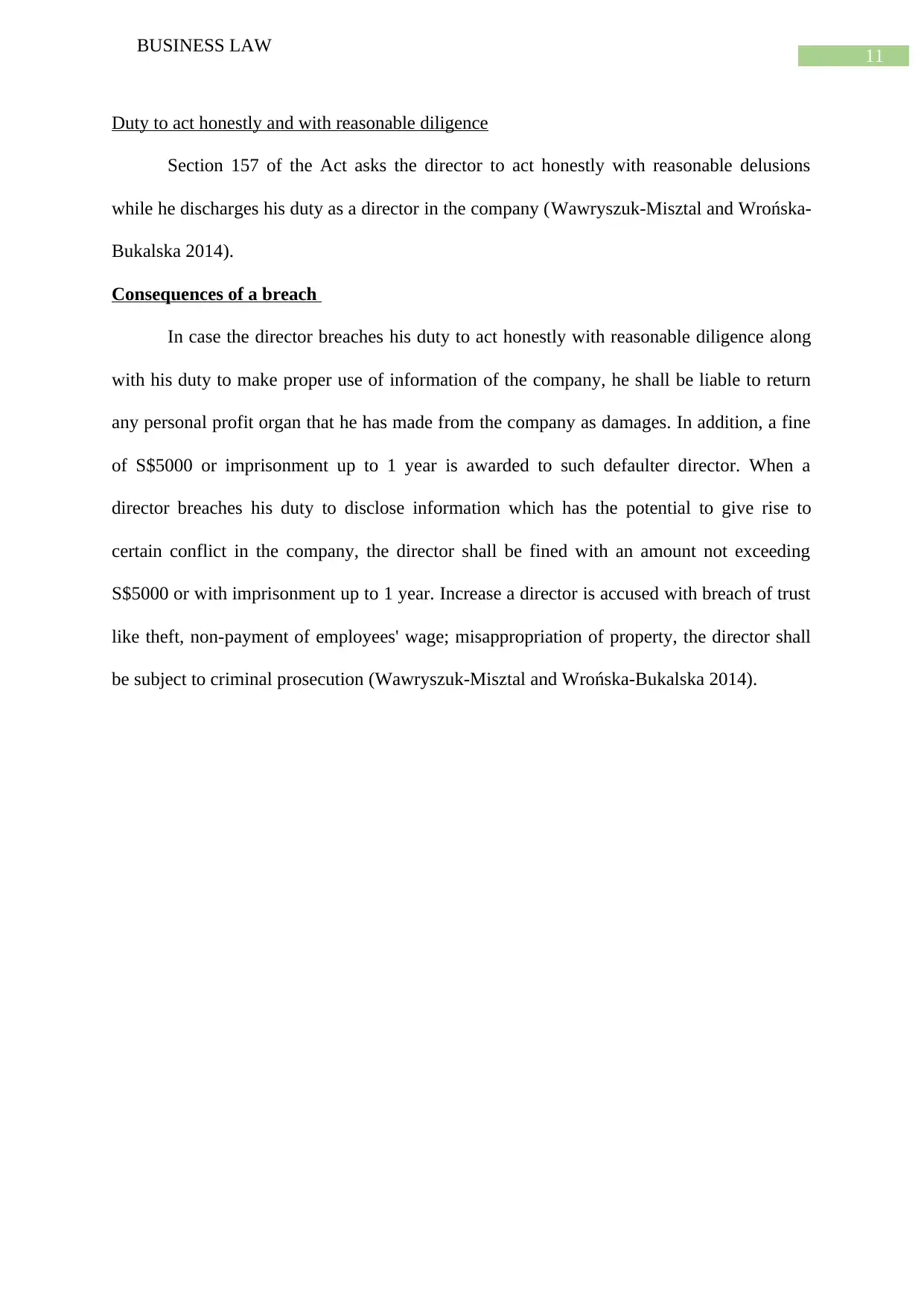
11
BUSINESS LAW
Duty to act honestly and with reasonable diligence
Section 157 of the Act asks the director to act honestly with reasonable delusions
while he discharges his duty as a director in the company (Wawryszuk-Misztal and Wrońska-
Bukalska 2014).
Consequences of a breach
In case the director breaches his duty to act honestly with reasonable diligence along
with his duty to make proper use of information of the company, he shall be liable to return
any personal profit organ that he has made from the company as damages. In addition, a fine
of S$5000 or imprisonment up to 1 year is awarded to such defaulter director. When a
director breaches his duty to disclose information which has the potential to give rise to
certain conflict in the company, the director shall be fined with an amount not exceeding
S$5000 or with imprisonment up to 1 year. Increase a director is accused with breach of trust
like theft, non-payment of employees' wage; misappropriation of property, the director shall
be subject to criminal prosecution (Wawryszuk-Misztal and Wrońska-Bukalska 2014).
BUSINESS LAW
Duty to act honestly and with reasonable diligence
Section 157 of the Act asks the director to act honestly with reasonable delusions
while he discharges his duty as a director in the company (Wawryszuk-Misztal and Wrońska-
Bukalska 2014).
Consequences of a breach
In case the director breaches his duty to act honestly with reasonable diligence along
with his duty to make proper use of information of the company, he shall be liable to return
any personal profit organ that he has made from the company as damages. In addition, a fine
of S$5000 or imprisonment up to 1 year is awarded to such defaulter director. When a
director breaches his duty to disclose information which has the potential to give rise to
certain conflict in the company, the director shall be fined with an amount not exceeding
S$5000 or with imprisonment up to 1 year. Increase a director is accused with breach of trust
like theft, non-payment of employees' wage; misappropriation of property, the director shall
be subject to criminal prosecution (Wawryszuk-Misztal and Wrońska-Bukalska 2014).
⊘ This is a preview!⊘
Do you want full access?
Subscribe today to unlock all pages.

Trusted by 1+ million students worldwide
1 out of 14
Related Documents
Your All-in-One AI-Powered Toolkit for Academic Success.
+13062052269
info@desklib.com
Available 24*7 on WhatsApp / Email
![[object Object]](/_next/static/media/star-bottom.7253800d.svg)
Unlock your academic potential
Copyright © 2020–2025 A2Z Services. All Rights Reserved. Developed and managed by ZUCOL.





